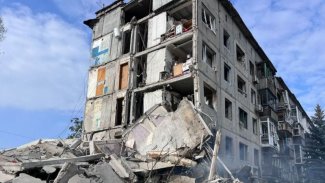Russian attacks across the whole front. Day 600 of the war

Russian forces are maintaining their increased level of activity in several directions, but they have not made significant ground advances. Avdiivka and its surroundings is still the scene of heavy fighting, into which the defenders have drawn reinforcements from less threatened areas, and are holding off the Russian attempts to deepen the city’s flanking from the north (in the area of the villages of Stepove and Berdychi, the Russians have probably still failed to gain permanent bridgeheads on the western side of the railway line from Avdiivka) and from the west (in the area of the villages of Tonenke and Sieverne). Ukrainian forces have also repulsed the first assaults on the coke-chemical plant which was their main redoubt. According to the local security services, it has been impossible to carry out search and rescue work due to the continuous shelling and bombardment of Avdiivka, and the delivery of humanitarian aid has been halted (1600 residents remained in the city as of 14 October).
Equally intense clashes are taking place in the area of Kupyansk, where the invaders are attempting to break through the Ukrainian defences on the outskirts of the town towards the north-east (fighting for Synkivka is ongoing); in the south-easterly direction, in the area of the villages of Ivanivka and Kyslivka, the defenders are trying to prevent the Russians from cutting the Kupyansk-Severodonetsk road. The number of hostile assaults on the defenders’ positions in the western part of Marinka has also increased once again; according to the Ukrainian General Staff, there have been 15–20 attacks per day in these areas during recent days, and the total number of daily Russian attacks has reached a level of 100, a figure not seen since last winter.
With less intensity, the Russians launched assaults on the Ukrainian positions on the border of Luhansk and Kharkiv oblasts, and made further attempts to regain the positions they lost as a result of the Ukrainian offensive south of Velyka Novosilka and to break through the defenders’ positions south-east of it. Both sides launched attacks south-west of Bakhmut, although neither was successful: the Ukrainians failed to break through the Russian defences along the Horlivka-Bakhmut railway line, while the Russians failed to retake the positions they had lost to its west, as well as those south of Orikhiv, where they were attempting to regain a small part of the positions they had previously lost (between Novoprokopivka and Robotyne, and west of Verbove). Ukrainian forces are continuing to try and reinforce their positions on the islands on the Dnieper and establish bridgeheads on its left bank.
On 17 October, the Russians carried out another strike on Odesa; however, according to local sources, little damage was caused there. The Ukrainian Air Force Command declared that all six Shahed-136/131 kamikaze drones and a Kh-59 missile had been shot down. The day before, the invaders struck military infrastructure targets near Khmelnytskyi and Kropyvnytskyi, as well as airfields at Starokostiantyniv in Khmelnytskyi oblast and Myrhorod in Poltava oblast. The Air Force Command reported shooting down 11 out of 12 Shahed-136/131 drones and two out of five Kh-59 missiles. The Russians were also said to have used an Iskander-M ballistic missile. On 16 October, Russian missiles from S-300 systems struck near the city of Dnipro in the area of Izium, twice (16 and 17 October) at Slovyansk, and at Zaporizhzhia on 15 October. Avdiivka was also hit by Russian missile strikes. According to communiqués from the Ukrainian General Staff, the number of rockets used by the enemy increased again, from two on 14 October to ten per day on the 15th and 16th. Meanwhile, according to local sources, the intensity of the Russian artillery and air strikes on Kherson and Nikopol increased.
On 17 October, the Strategic Communication Board of the Ukrainian army reported attacks on Russian airfields in the occupied regions of Berdyansk and Luhansk, which allegedly resulted in two helicopters being hit. In a later communiqué, the Special Operations Forces reported that nine Russian helicopters, an air defence system launcher and an ammunition depot had been destroyed in the attacks, while dozens of Russian soldiers had been killed and wounded. According to Russian sources, the Ukrainians also repeated drone attacks on the Russian border regions and occupied Crimea, but without success. On 14 October, Ukrainian Navy spokesman Dmytro Pletenchuk referred to earlier reports of damage to Russian ships off the Sevastopol roadstead. The missile corvette Pavel Derzhavin was said to have been hit twice (on 11 and 13 October) by Ukrainian drones (presumably the defenders were using submarine drones for the first time), but this did not prevent it from continuing its independent cruise to Novorossiysk. Instead, the tug Professor Nikolai Muru was damaged. Pletenchuk did not confirm the SBU’s reports that a missile ship called the Buyan had been hit; but at the same time he failed to correct a factual error, namely that no vessel of this name exists in the Russian Navy, and that the term ‘Buyan’ refers to a type of artillery corvette, three of which are based in the Caspian Sea.
On 13 October, the German government announced a new military support package for Ukraine, including four BV206 articulated tracked carriers and two HX81 trucks with trailers for the transport of heavy armaments. On the same day, during a meeting with President Volodymyr Zelenski in Odesa, Dutch Prime Minister Mark Rutte announced his intention to deliver additional missiles for Patriot air defence systems. On 14 October, the Deputy Head of the Office of the President of Ukraine Ihor Zhovkva announced that a training centre for Ukrainian pilots would be set up and launched in Romania by the end of this year.
On 16 October, British military intelligence indicated that some of the Wagner Group’s mercenaries were moving over to a ‘private military company’ called Redut. This group is overseen by Russian military intelligence, and probably numbers around 7000 men. According to the British, the continued recruitment of volunteers has made it possible for Moscow to delay the announcement of a new wave of mass mobilisation.
Also on 16 October, Russia’s finance minister Anton Siluanov admitted that almost all of the drones the Russian Federation has used come from the People’s Republic of China. At the same time, he announced the launch of a Russian programme to ensure their production. According to Siluanov’s declaration, 60 billion roubles (more than $600m) will be allocated to this programme.
On 14 October, Ukrainian military intelligence (HUR) spokesman Andriy Yusov warned that the Kremlin has not given up on its plan to draw the Belarusian army into armed conflict with Ukraine. According to HUR, the Russian special services have precise information about the critical infrastructure facilities in Belarus, and it is possible that they will decide to launch a provocative attack on one of them and blame Ukrainian forces for it. Earlier, the Ukrainian government indicated that one such provocation could take place at the fuel base in the area of the village of Pryluki in the Brest region, located just 2 km from the border with Poland.
On 13 October, the Ukrainian border service reported that up to 30 people trying to leave the country illegally are being detained every day (most on the borders with Romania and Moldova). Since February last year, some 15,800 men have been detained attempting to cross the ‘green border’, and 6900 have been caught using falsified permits to leave Ukrainian territory. The most common ways to cross the border illegally are entering into marriages of convenience with mothers who have many children, and by accompanying people with disabilities.
On 16 October, the Ukrainian Ministry of Defence announced that the number of women in the armed forces had reached 43,000. It was emphasised that all restrictions on their access to serve in combat conditions had been lifted. Previously, women had held various posts in medical, communications, and financial & logistical specialisations, but they can now serve as drivers, sharpshooters or commanders of infantry fighting vehicles.
On the same day, Ukrainian local authorities reported that diversionary groups had eliminated 26 Russian occupiers in Mariupol over the past week. It was reported that between June and October, 40 Russians had been killed in the occupied city as a result of ‘guerrilla’ activity.
Commentary
- The invaders’ renewed offensives in the area of Avdiivka are reminiscent of the battles for Bakhmut which took place last winter and this spring. In both cases, the Russians outflanked the town while launching attacks directly on the urbanised area. So far, Russian forces have failed in their attempt to take Avdiivka in what is known as an operational encirclement; their success in doing this during the fighting for Bakhmut in spring paralysed the defenders’ logistics, and led to the enemy seizing the city. It remains unclear whether the Russians will succeed in repeating this manoeuvre in the coming weeks (if at all); indeed, the situation for Avdiivka’s defenders is far more favourable than that of those who were defending Bakhmut. The town has been in the frontline zone continuously since 2014, and has been transformed into a de facto fortress over the last eight years, with dozens of fortified Ukrainian defence points in its vicinity.
- The flanking of Avdiivka from the north and south-west, which the invaders are now attempting to enlarge, has taken many months and caused significant losses to the Russians. Avdiivka also has a completely different military significance to Bakhmut: its seizure is not necessary from the perspective of opening the road to the centre of the Ukrainian-controlled part of Donetsk oblast (Slavyansk-Kramatorsk), but it is of significant importance from the perspective of Russia retaining the relative freedom of its control over Donetsk city. The second such locality, over which fighting has also been ongoing since 2014, is Marinka, which flanks the occupied regional capital from the west.
- By intensifying their offensive operations in several directions at once, the Russians seem convinced that the measures they have taken over the past several months to expand and strengthen their own military potential (forming new operational and tactical compounds, and increasing arms & ammunition production) have been effective, while at the same time significantly weakening their opponent. However, while it is highly likely that the Ukrainians have exhausted their offensive capabilities in their attacks in the south and in the region of Bakhmut, gradually committing essentially all their reserves to attempts to break through Russian defences, they still have a significant defensive potential: one important element of this is their systematically expanded system of fortifications (similar to the Russian defensive lines against which the Ukrainian offensive collapsed). This makes it highly unlikely that the Russians will achieve any profound breakthroughs which would allow them to return to full-scale manoeuvring operations.






